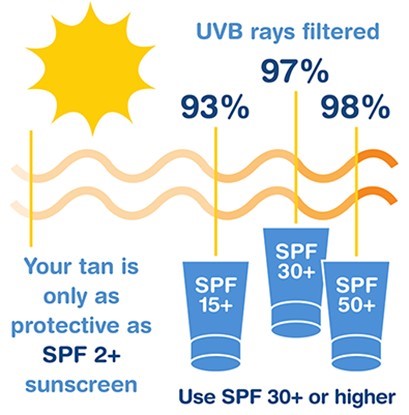Welcome to July! One of the hottest months, and likely one when we’re outside, hiking, biking, camping, swimming or sitting by the pool. With all the “SPF Broad Spectrum” labels out there, things can get confusing. Hopefully this can help you sort out what to look for and how to protect your skin from getting burned.
What does “broad spectrum” mean?
Broad spectrum means that the sunscreen ingredients cover both UVA and UVB rays. UVB are the rays that cause your skin to tan or burn. The rays do not penetrate windows. However, the sun also has UVA rays, which CAN penetrate glass that is not specifically tinted or protected against this. While UVA rays do not cause our skin to burn, they are absorbed into our skin more deeply and are shown to cause damage into our deeper layer of skin, the dermis. This can lead to changes in DNA, and increased wrinkles and loss of collagen. The most common ingredients that deliver protection in “broad spectrum” sunscreens tend to either be Zinc Oxide, Titanium Dioxide or Avobenzone, often combined with other ingredients.

What does “SPF” mean?
SPF, or Sun Protection Factor, means how much longer you can theoretically be in the sun than WITHOUT sunscreen before getting burned by UVB rays. This will be different for patients with different skin types. Obviously, someone with fair skin will burn faster, while someone with very dark skin may never burn. In Colorado, we live at altitude, and the sun’s ray are more intense than at sea level. For this reason, while many articles suggest an SPF of 15, we would recommend an SPF of 30 or higher. But the SPF does not guarantee you won’t get damage from UVA rays UNLESS is says “Broad Spectrum.”
Why do I still burn or tan even though I applied sunscreen?
There can be several reasons – the most obvious, it wore off or did not apply enough. The SPF ratings are based on a generous application reapplied to the skin every 2 hours. This is “perfect use.” Of course, we are human and are not perfect, so unless we are reapplying every 2 hours with outdoor activity, the sunscreen can wear off from sweat, water, friction and clothing.

Also, even with an SPF of 15, you are blocking 93% of the sun’s rays, but 7% still get through. An SPF of 50 blocks 98% of sun’s rays, allowing only 2% to get through. See the chart below. So, a higher number is generally better, if used appropriately and reapplied.
Should I buy SPF clothing?
While SPF clothing is usually coated or made with special fabrics to provide a certain level of SPF, even non-rated clothing can be effective in blocking damaging rays to the sun. A small test study done in 2014 found that some SPF rated clothing was equal or close to regular clothing that has a thick tight weave, such as denim or thick cotton.1 Light fabrics that are see-through or transparent would not be as useful in blocking rays.
Mineral vs Chemical Sunscreens?
Mineral based sunscreens contain either zinc oxide, titanium dioxide, or both. These work by sitting on the surface of the skin and reflecting the sun’s rays back into the atmosphere. Chemical sunscreens, which often contain avobenzone, oxybenzone, octocrylene, or octinoxate, work by absorbing the UVB rays while on the skin and neutralizing them. For people with sensitive skin, pure zinc oxide tends to be best tolerated over chemical sunscreens.
In May of 2019, an FDA study published in the Journal of the American Medical Association looked at absorption of chemical sunscreens in the blood of 24 healthy volunteers with maximal use – this meant application of several ounces to the body every 2 hours over several days. They found that all the ingredients tested, which included avobenzone, oxybenzone, octocrylene and ecamsule, were found in very high concentrations in the blood.2 This study was the first of its kind. The significance of what this means is still unknown. The FDA will be conducting further toxicology testing to evaluate the risks. Also, oxybenzone is one of the ingredients that may contribute to coral reef damage, so best to avoid if you are traveling on a beach vacation.
Mineral sunscreens containing zinc oxide and titanium dioxide are not thought to be absorbed in the blood stream and are deemed as safe. So, if you have concerns but still want to live an outdoor lifestyle, wear clothing with a tight weave, wear rash guard tops in the water while snorkeling or swimming, wear hats that have a wide brim, use sunscreens with primarily zinc oxide or titanium dioxide (see the Elta brand we carry in-house), and seek shade when you can. Other good sunscreen names that you can get over the counter or online include Coola, CeraVe (with Zinc), Badger, Blue Lizard, or Vanicream.
- Blog content written by Joanna Baskett, PA-C
- 1 – Kenneth Bielinski, MD; Nolan Bielinski, BS, (2014) UV radiation transmittance: regular clothing vs sun protective clothing, Cutis, 94,135-138
- 2 – Murali K. Matta, PhD1; Robbert Zusterzeel, MD, PhD, MPH1; Nageswara R. Pilli, PhD1; et al. (2019) Effect of sunscreen application under maximal use conditions on plasma concentration of sunscreen active ingredients. JAMA, 21,2082-2091